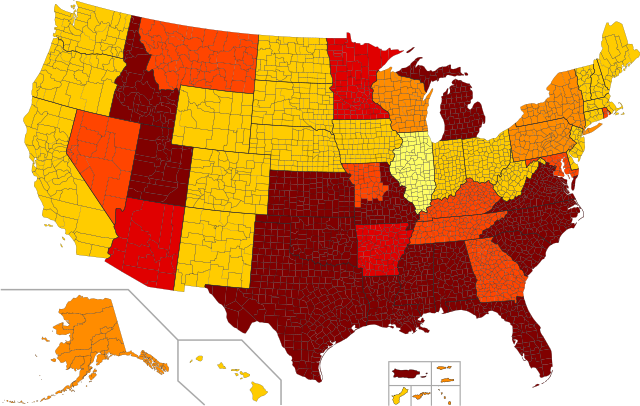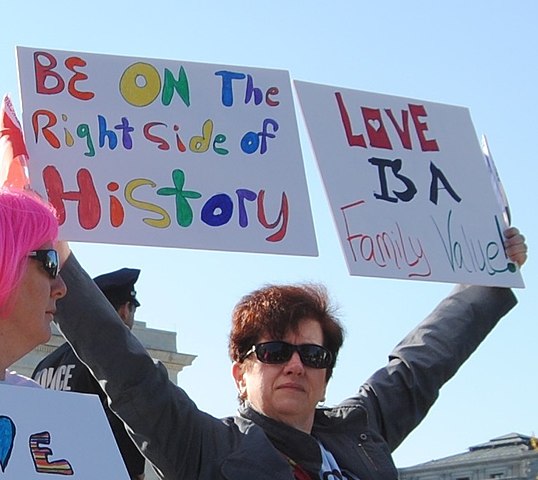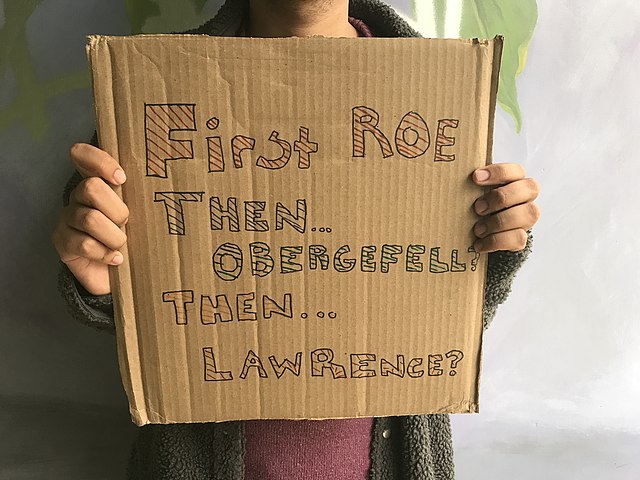Get ready for more discussion of of glory holes than you’ve ever heard in a civics lesson before. This landmark case invalidated sodomy laws across the United States. But did the plaintiffs involved actually commit sodomy with each other? And is the Supreme Court’s legal reasoning at risk today?
Featured image: A protest sign warning that if the privacy protections of Roe v. Wade fall, then Obergefell (same-sex marriage) and Lawrence (sodomy) may follow. (Image source)

A map of sodomy laws in the United States. The darkest red states had sodomy laws that were struck down by the Lawrence v. Texas Supreme Court decision. Although these laws were struck down by the decision, many are still on the books–which means they can go into effect if Lawrence v. Texas is ever overturned. (Image source)

A demonstration outside the Supreme Court before the landmark Obergefell v. Hodges case (I’m having a hard time finding photos with a creative commons license specifically from Lawrence v. Texas case; phones with cameras were a lot less common in 2003 and people weren’t documenting events for creative commons organizations like Wikimedia, so most of the photos I could find may be owned by news organizations). (Image source)

Counter-protesters at the Supreme Court before the Obergefell v. Hodges decision, calling on the court to roll back Roe v. Wade, Lawrence v. Texas, and apparently also the First Amendment? (Image source)
Sources
Early history of sodomy laws
- The Buggery Act 1533
- The Myth of Lesbian Impunity Capital Laws from 1270 to 1791
- The Last Men Executed for Sodomy in England, 1835
- The Sensibilities of Our Forefathers: The History of Sodomy Laws in the United States
- Procedure and Strategy In Gay Rights Litigation
- State v. Morales
- Bowers v. Hardwick, 478 U.S. 186 (1986)
The Lawrence v. Texas case and plaintiffs
- Extreme Makeover: The story behind the story of Lawrence v. Texas.
- Lambda Legal: Lawrence v. Texas
- Tyron Garner, 39, Plaintiff in Pivotal Sodomy Case, Dies
- John Lawrence, Plaintiff in Gay Rights Case, Dies at 68
Other legal sources
- Nolo contendere
- 14th Amendment
- Estelle T. GRISWOLD et al. Appellants, v. STATE OF CONNECTICUT.
- Legal Information Institute: Privacy
- Zone of Privacy
- Roe v. Wade
- Supreme Court has voted to overturn abortion rights, draft opinion shows
- Read Justice Alito’s initial draft abortion opinion which would overturn Roe v. Wade
- If Roe v. Wade falls, are LGBTQ rights next?
- The Repeal of Roe v. Wade Is a Direct Threat to Gay Marriage
- There are 16 states in the US that still have sodomy laws against ‘perverted sexual practice’. It’s 2020
